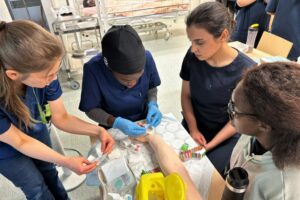Learning Finnish in authentic situations motivates, engages, and strengthens professional self-esteem
Learning Finnish in authentic situations motivates, engages, and strengthens professional self-esteem. Learning the language in real environments provides an opportunity to experience strong participation and gives meaning to language development. The actual environment gives a boost to the motivation and confidence of the student.
In the Diploma in General Nursing outside the EU/EEA project, the competence of nurses arriving in Finland from outside the EU and EEA is enhanced. The supplementary training, conducted in five universities of applied sciences, includes the study of both the Finnish language and nursing content. Finnish is learned through both online courses and practical training, with a strong integration of language learning into professional content.

Finnish is studied in various environments
In Finnish universities of applied sciences, nursing Finnish is studied not only in traditional classroom settings but also in various authentic or authentic-simulated situations. Simulated situations have been experimented with and developed in projects such as SOTE-silta and Urareitti. Authentic learning environments are strongly integrated into the Diploma in General Nursing outside the EU/EEA project as well.
In this context, simulation refers to an educational method where nursing practice is mimicked in a safe environment. The method involves goal-setting, authenticity, and the students' process, progressing from preparation to performance and ultimately debriefing. (See Kuparinen 2021.)
"Simulation provides the opportunity to experience what it would feel like to be in a real working environment."
In simulations, the Finnish language teacher collaborates with the nursing lecturer in planning, teaching, and assessment. The Finnish language teacher also works as a professional teacher's partner in workshops, where the nursing teacher focuses on practical skills, and together with the Finnish language teacher, they practice how a nurse narrates their own actions, for example, when taking a blood sample.
A genuine environment offers various advantages
In authentic learning environments, learning supports the idea that language acquisition is seen as a process that progresses gradually with the support of the wider community. Linking language learning to authentic learning situations can support the agency of students, which education should strengthen. (Virtanen 2017.)
"Learning something new is what motivates studying, even though preparing for simulation classroom exercises may sometimes feel challenging."
Realistic environments bring hands-on learning, which is essential in all learning. Language is not just theory; it happens and is realized in various professional communication situations. Authentic situations also diversify language learning, as the learner's role is different as an actor or observer. Different roles can provide new perspectives on one's own actions, and the learner can gain insights that classroom learning, online learning, or independent study may not produce.
Furthermore, engaging in simulation situations motivates and commits students. When there is no time to focus on language structures and other details, all means of conveying the message are meaningful. Interaction can be successful in many ways.
The professional role brings confidence to language practice
As the learner possesses substantive knowledge in nursing, assuming the professional role can also facilitate language learning. In these situations, the learner gains experiences of success by compensating for language skills through non-verbal communication as well. (See Virtanen 2017.)
Engaging in authentic situations also creates scenarios that teachers may not have anticipated. Being prepared for unexpected nursing situations strengthens professional identity and, simultaneously, the courage to use language grows.
Professional language proficiency is context-dependent, so the learned material may not easily align with the learner's needs, especially in classroom or online learning. In simulation-based learning, language learners can also receive assistance from other participants or the environment, allowing language learning to progress with community support and strengthening the learner's agency.
"If you genuinely want to work in Finland and be a good colleague to others,
it is advisable to study Finnish-language simulation exercises."
Both authors work as Finnish as a Second Language lecturers at Oulu University of Applied Sciences Language Centre.
The quotes are from a Finnish as a Second Language student who has completed a nursing degree at Oulu University of Applied Sciences.
For the text, Finnish as a Second Language lecturers from Laurea, Tampere University of Applied Sciences, Turku University of Applied Sciences, and Savonia, who are involved in the Nurse in Finland project, were interviewed.
Karoliina Pigg, Lecturer, Oulu University of Applied Sciences
Hanna Poussu, Lecturer, Oulu University of Applied Sciences
Sources:
Kuparinen, Kristiina 2021. Matkalla todelliseen maailmaan. Hoitotyöhön integroitua S2-opiskelua simulaation keinoin. Teoksessa Viesti kielillä – kuulu kaikille (toim. Pipsa Kostamo ja Minna-Kaisa Lehtilinna) Laurean kielten ja viestinnän opetuksen käytänteitä. Laurea Ammattikorkeakoulu. S. 6 – 11.
Rajala, S. & Takaeilola, M. (2017). Ammatillisen kielitaidon kehittyminen sairaanhoitajien pätevöitymiskoulutuksessa. Kieli, koulutus ja yhteiskunta, 8(5). Hakupäivä 19.4.2023. Ammatillisen kielitaidon kehittyminen sairaanhoitajien pätevöitymiskoulutuksessa — Suomi (kieliverkosto.fi)
Virtanen, A. 2011. Käsityksiä kansainvälisesti rekrytoitujen hoitajien ammatillisesta kielitaidosta ja sen kehittymisestä: Mediakeskusteluiden ja asiantuntijan haastattelun analyysia [Beliefs about international nurses’ language skills and their development: Analysis of media discussion and an expert interview]. Puhe ja kieli [Speech and communication], 31(4), 153–172.